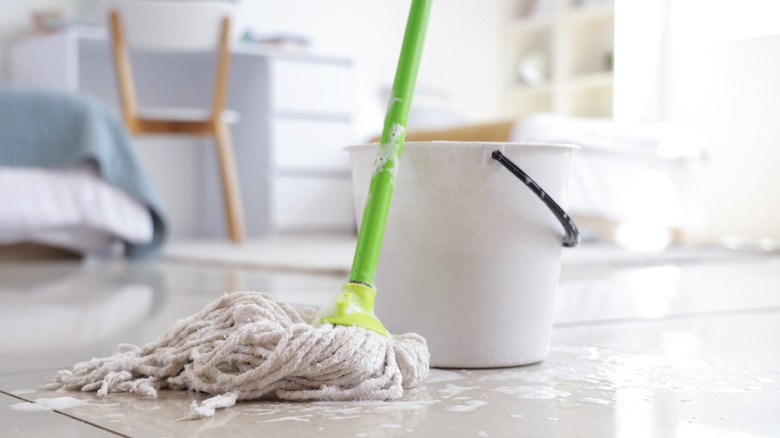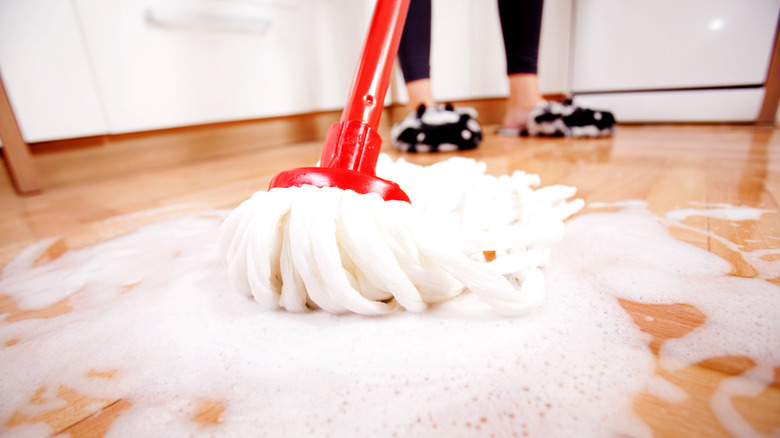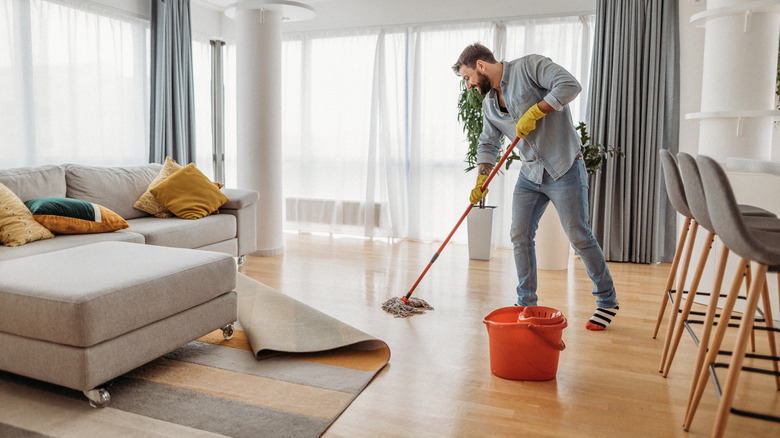The Real Reason Your Floors Smell After Mopping (And How To Fix It)
It is easy enough to remember to mop your floors, but how often do any of us ever remember to clean our mops? If you have been wondering why your floors are not smelling good after mopping lately, there's one sneaky culprit you probably haven't considered: the mop itself. Yes, even though they see a bucket of cleaning chemicals on occasion, mops get dirty too and can easily spread the odor-causing dirt, bacteria, and even mold they collect back onto your floors if they are not regularly cleaned.
A dirty mop head is a common issue; after all, we use mops to collect dirt and grime, so it makes sense that some may still be hanging out there between cleanings. The problem is that many people simply give their mop a rinse when done and hang it up to dry, which is not always enough to kill any nasty gunk that didn't get rinsed off. This can make mop heads a microbial hotspot. And unfortunately, the porous design of some mop fiber types allows these microorganisms to nestle deep within them, making it super difficult to get them back out with a simple rinse. So, the more you use your mop without sanitizing it, the more bacteria you end up introducing to your floors.
Dealing with excess residual solution in your mop
The good news is that preventing this issue to begin with is simple and easy to implement. First and foremost, you need to properly sanitize your mop head after every use. For microfiber or cotton mop heads, a quick and effective method is to machine wash them, using hot water with a small dose of detergent to kill off any lingering bacteria and mold. Allow the mop head to air dry completely before reattaching it to the handle.
If your mop head is not machine washable, don't fret: you can still sanitize it by soaking it in a bucket of hot water mixed with a disinfectant solution, such as a capful of bleach or some white vinegar. Let it soak for at least 30 minutes, give it a thorough rinse, then wring out as much water as possible; from there, the most important step is proper drying.
Additionally, never store a damp mop in a dark, enclosed space like a closet. Instead, hang it in a well-ventilated area with good circulation to help it dry completely, like this genius space-saving mop storage solution. You can even enlist any fans you have to help with the task. A clean, fresh mop is the only way to guarantee that your floors will smell fresh and clean after every mopping session.
Other tips to keep your floors fresh, not smelly
If you are tired of constantly battling a smelly mop (and floor), the best solution is to upgrade to a better and more hygienic mop. Not all mops are created equal, and some are made with materials and even have features that actively resist the growth of those nasty odor-causing bacteria. Microfiber mops are a fantastic, popular choice for this reason. Their synthetic fibers are less porous than traditional cotton, so that helps them trap dirt and germs way more effectively while also drying much faster. They also sport removable, machine-washable pads that make sanitation a breeze, allowing you to wash away any funky stuff lingering post-rinse in a single laundry cycle — washing between uses is a great hack to keep your mop clean.
For an even deeper clean, consider a steam mop. These gadgets use the power of high-temperature steam to sanitize your floors, killing 99.9% of germs and bacteria without using any chemicals. This intense heat not only cleans but sterilizes, ensuring no residue of any kind is left behind to cause an unpleasant odor. And best of all, the mop pads on steam mops are typically microfiber, which are easy to clean and replace. By choosing a mop designed to better handle hygiene, you can proactively prevent the root cause of the problem and enjoy shiny clean floors that look (and smell) great.


